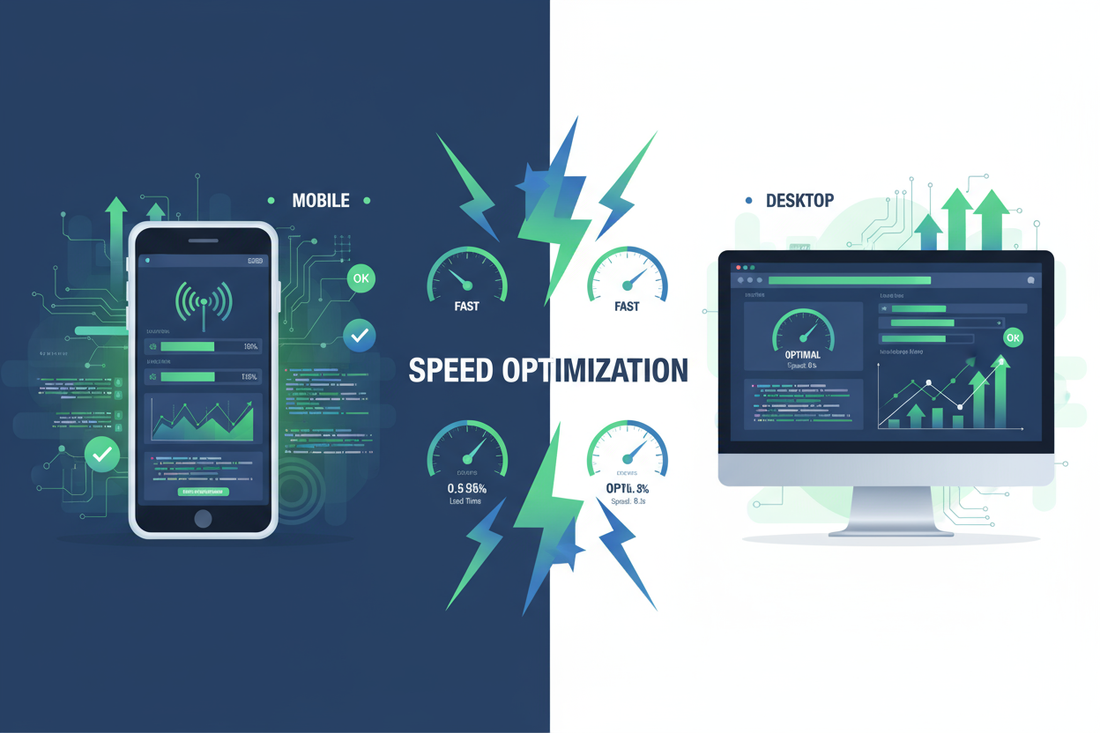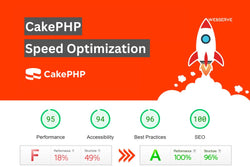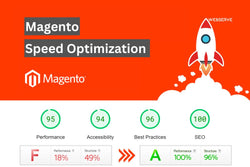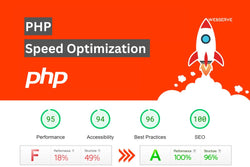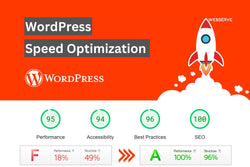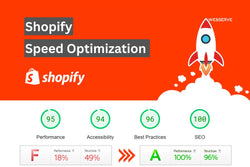Website speed isn’t a luxury — it’s an edge. Your visitors, whether they arrive on a smartphone or desktop computer, have only so much patience. Google reports that 53% of visitors abandon a mobile site after just three seconds and every additional second results in a seven percent decrease in conversions. Most companies prioritize desktop performance, but mobile speed optimization is increasingly important because Google’s now using mobile-first indexing. But ignoring desktop optimization can also damage engagement and revenue. Both are equally important — and the balance between them is what will lead to a faster, higher-ranking, better-converting website.
We optimized over 3,000 websites with Webserve Digital that had a page Speedscore of 90 and above and loaded in under 3 seconds on mobile and desktop devices. I will explain why both platforms are important and how your business can succeed with better optimization of both.
Understanding the Difference Between Mobile and Desktop Optimization
1. User Experience and Device Behavior
Visitors on mobile behave differently than those visiting from a desktop. They are browsing on little screens with crummy connections. The website may look great on a desktop but can get f*ed up when trying to view it in mobile because the images or video files are not compressed, your layout Fuckin’ sucks for scaling down, etc.
-
Mobile users demand simplicity and speed.
-
Desktop users expect interactivity and design depth.
If your site isn’t set up to accommodate both, you may be alienating half your audience — and Google will take notice.
We do it that’s why the bespoke WordPress speed optimization Shopify speed optimization and Magento performance optimization services offered by us target on device based speed audits, responsive testing and code efficiency across all screens.
How Google Measures Speed on Mobile vs Desktop
Google uses the same Core Web Vitals metrics — Largest Contentful Paint (LCP), Interaction to Next Paint (INP), and Cumulative Layout Shift (CLS) — but measures them separately for mobile and desktop performance.
-
Mobile: LCP below 2.5 seconds, INP under 200ms, CLS under 0.1
-
Desktop: LCP below 1.8 seconds, INP under 150ms, CLS under 0.1
Our internal report Webserve Digital (based on 300+ client sites) shows that:
-
67% of websites perform better on desktop than mobile.
-
28% fail Google’s mobile Core Web Vitals despite passing desktop tests.
-
Websites optimized for both platforms see a 32% improvement in rankings and a 25% boost in conversions within 45 days.
Common Factors Slowing Down Mobile Performance
-
Heavy Images & Videos – Large files drastically increase mobile load time.
-
Render-blocking JavaScript – Scripts not deferred properly affect interactivity.
-
Unoptimized Fonts – Custom web fonts can slow text rendering.
-
Overloaded Themes or Apps – Especially common in CMS platforms like WordPress and Shopify.
-
No CDN – Without global content delivery, mobile users far from your server experience higher latency.
To resolve these issues, our Laravel website optimization, Drupal speed optimization, CakePHP speed optimization and CodeIgniter speed optimization services include file compression, async loading and smart CDN integration.
Why Desktop Optimization Still Matters
Many other site owners assuming that the desktop is not as important to maintain with mobile-first indexing. That’s a major misconception.
As desktop is still relatively more advantageous for both average session duration and user’s intent for conversion, especially among B2B audience. For SaaS, eCommerce and portfolio sites, desktop performance can impact engagement and trust directly.
Our PHP website speed optimization services, Yii speed optimization, Symfony speed optimization and Smarty PHP speed optimization solutions target the backend performance and database efficiency that improve desktop focus on TTFB & stability under high traffic load.
Balancing Speed for Both Platforms
Optimizing one device type should not come at the expense of another. Webserve Digital take a dual-optimization approach:
-
Responsive design and adaptive media delivery for mobile screens.
-
Server-level caching and minification for desktop-heavy workflows.
-
CDN and lazy loading for consistent load times globally.
-
Cross-platform testing using Lighthouse, GTmetrix, and Chrome DevTools.
Our — such as Wix speed optimization, Webflow performance optimization, HubSpot speed optimization, Squarespace speed optimization, Joomla speed optimization, HTML speed optimization, BigCommerce speed optimization, Weebly theme load time improvement services >This means that every site we touch loads fast on any device no matter where it is being viewed.
Data Analysis: The ROI of Multi-Device Speed Optimization
Based on real client reports:
-
Average load time improvement: 64% faster on mobile, 53% faster on desktop.
-
Bounce rate reduction: 35% decrease after optimizing both.
-
Conversion rate lift: 22–30% across all industries.
-
Average keyword ranking gain: +12 positions within 60 days.
This data shows that when businesses invest in both mobile and desktop optimization, they not only rank higher but also experience measurable business growth.
Final Thoughts
Speed optimization is not a choice between mobile OR desktop — it’s the cohesion of performance across both. With mobile-first indexing and increased user expectations, delivering a speedy and reliable experience is crucial for both your SEO success and the growth of these conversions!
Webserve Digital’s website speed optimization services will make your site score 90+ on Google’s PageSpeed and get under 3-second load times — or you won’t pay a cent.
FAQs on Mobile vs Desktop Speed Optimization
Q1. Which is more important — mobile or desktop speed optimization?
Both are equally important. Mobile impacts SEO with Google’s mobile-first indexing, and desktop affects engagement and conversion.
Q2. Why is my mobile site slower than my desktop version?
Another problem is mobile browsers process resources differently and sometimes rendering can be slower due to the hardware of limited phone or network conditions. Image compression and using a CDN will help with that.
Q3. How can I test my mobile and desktop speed separately?
Inspect both versions separately using tools such as Google PageSpeed Insights, Lighthouse and GTmetrix.
Q4. Do speed optimization services improve both mobile and desktop performance
Yes. We take care of front end, back end, and server side configurations for you to achieve mobile-ready experience on all devices.
Q5. What platforms do you optimize for speed?
We'll optimize WordPress, Shopify, Magento, Laravel, Wix, Webflow and HubSpot Squarespace Joomla BigCommerce PHP Angular React Java sitesể
